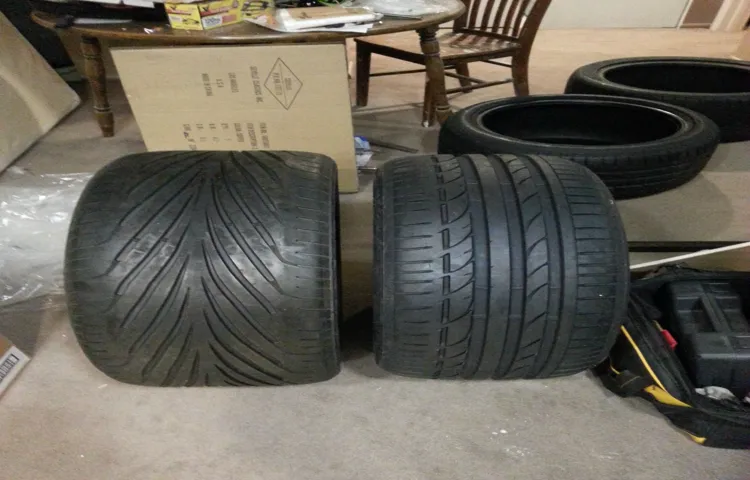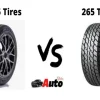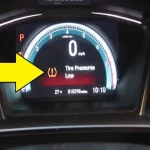Have you ever wondered about the width of a 315 tire? It may not be something you think about on a regular basis, but if you’re in the market for new tires or simply curious about the specifications of your current ones, it’s an important factor to consider. After all, the width of your tire can impact everything from your vehicle’s performance to its overall appearance. So, how wide is a 315 tire exactly? Let’s dive into the details and explore what this measurement really means.
Table of Contents
Overview of Tire Sizing
If you’re wondering how wide a 315 tire is, the answer depends on a few factors. First, it’s important to understand tire sizing and how it’s represented. The width of a tire is represented by the first number in the tire’s size code.
So, for a tire listed as 315/70R17, the width is 315 millimeters. However, it’s important to keep in mind that the width of a tire can vary based on the rim width it’s mounted on. A wider rim will result in a wider tire, while a narrower rim will result in a narrower tire.
Additionally, the aspect ratio (second number in the size code) and overall diameter of the tire can also affect its width. So, while a 315 tire may be wider than other sizes, it’s important to consider the complete tire size code and how it relates to your specific vehicle.
Understanding Tire Measurements
When it comes to understanding tire measurements, things can get a bit confusing. The three main measurements you need to be familiar with are the tire width, aspect ratio, and wheel diameter. The tire width is simply the width of the tire from one sidewall to the other.
The aspect ratio is the ratio of the height of the tire’s sidewall to its width. Finally, the wheel diameter is the size of the wheel that the tire will fit on. For example, a tire size of 205/55R16 means the tire is 205mm wide, the aspect ratio is 55%, and it fits on a 16-inch wheel.
It’s important to note that using the correct tire size is important for safety and performance, as well as complying with vehicle manufacturer recommendations. So next time you’re in the market for new tires or just want to better understand the ones you currently have, pay attention to these important measurements.

Breaking Down the Numbers in a 315 Tire
Tire sizing can be confusing, especially when trying to decipher the numbers on the sidewall of the tire. A 315 tire refers to the tire’s width in millimeters from sidewall to sidewall. But, that number alone doesn’t provide a clear picture of the tire’s size.
The number following the slash indicates the aspect ratio or the height of the tire’s sidewall as a percentage of its width. For example, a 315/70R17 tire has a sidewall height that is 70% of the tire’s width. The letter that comes after the aspect ratio indicates the tire’s construction.
In the example of 315/70R17, the “R” signifies that the tire is of radial construction. Finally, the last number indicates the diameter of the wheel in inches, on which the tire is intended to fit. Understanding tire sizing is essential to ensure that you choose the right tire for your vehicle, and it can also help you understand how to optimize your performance on the road.
Determining the Width of a 315 Tire
For those wondering how wide a 315 tire is, the answer is that it varies depending on the specific manufacturer and model. Generally speaking, a 315 tire is wider than most standard tires and is typically used on larger vehicles such as trucks and SUVs. To determine the exact width of a 315 tire, it’s important to look at the tire’s specifications, which can typically be found on the sidewall.
This will include information on the tire’s width, aspect ratio, and diameter, among other details. It’s important to note that while a wider tire can provide better stability and handling, it can also have an impact on fuel efficiency. So, it’s important to consider your specific driving needs and preferences before choosing a tire width.
Calculating the Width of a 315 Tire Using Aspect Ratio and Rim Size
Determining the width of a 315 tire can seem like a daunting task, but it’s actually quite simple when you understand how to use the aspect ratio and rim size. The aspect ratio is the height of the tire’s sidewall as a percentage of the width, and the rim size is the diameter of the tire’s wheel. To calculate the width of a 315 tire, you’ll need to use these two numbers in a formula.
First, convert the aspect ratio to a decimal by dividing it by 100. Next, multiply the decimal by the width of the tire, which is 315 mm in this case. Then, add twice the rim size (in inches) and convert the result to millimeters.
Finally, round the answer to the nearest tenth. For example, if the aspect ratio is 50 and the rim size is 18 inches, the width of the 315 tire would be approximately 14 inches.
By learning how to use these two simple measurements, you can easily determine the width of any tire size you need.
Using a Tire Size Calculator to Find the Width of a 315 Tire
Determining the width of a 315 tire may seem like a daunting task, but with the help of a tire size calculator, it can actually be quite simple. The first step is to input the tire size, which in this case would be 31 Next, the calculator will ask for the aspect ratio, which is the height of the tire compared to its width.
This information can typically be found on the sidewall of the tire. Once the aspect ratio is inputted, the calculator will be able to determine the width of the tire. It’s important to note that the final measurement may not be an exact number, but rather rounded to the nearest tenth or hundredth of an inch.
By utilizing a tire size calculator, you can be sure that you are getting an accurate measurement of the width of your 315 tire.
Consulting the Manufacturer’s Specifications
When it comes to determining the width of a 315 tire, consulting the manufacturer’s specifications is crucial. While there are general guidelines for tire size, it’s important to follow the specifications set by the manufacturer to ensure optimal performance and safety. These specifications can typically be found in the owner’s manual or on the manufacturer’s website.
To determine the width of a 315 tire, it’s important to look for the numbers on the sidewall of the tire. The first number indicates the width of the tire in millimeters. In the case of a 315 tire, the width would be 315 millimeters.
However, it’s important to note that this number is not always an exact measurement and may vary slightly depending on the tire’s design. Other factors to consider when determining the width of a tire include the aspect ratio, which is the ratio of the tire’s height to its width, and the diameter of the rim. By consulting the manufacturer’s specifications, you can ensure that you’re choosing the right tire size for your vehicle and that it will provide optimal performance and safety on the road.
In summary, determining the width of a 315 tire requires consulting the manufacturer’s specifications to ensure proper sizing and optimal performance. While the number on the sidewall of the tire is a good starting point, it’s important to consider other factors such as the aspect ratio and rim diameter. By following the manufacturer’s guidelines, you can enjoy a safe and comfortable driving experience.
Common Uses for a 315 Tire
“How wide is a 315 tire?” is a common question among those looking for a specific type of tire for their vehicle. A 315 tire generally has a width of 315 millimeters, making it a wider tire than most standard options. This extra width provides increased traction and stability on the road, making it a popular choice for drivers of high-performance vehicles or those who frequently drive on rough terrain.
Some common uses for a 315 tire include sports cars, SUVs, pickup trucks, and off-road vehicles. Additionally, these tires are often used in racing or other high-speed applications because they are better able to handle the increased stresses and demands of these environments. Whether you’re a serious driver or simply want an upgrade for your vehicle, a 315 tire is an excellent choice for those looking for improved performance and handling.
Fitting a 315 Tire on Specific Vehicle Models
The 315 tire is a popular choice for those looking for a wider and more aggressive tire for their vehicle. It is commonly used on trucks and SUVs for off-roading and other heavy-duty activities. However, fitting a 315 tire on a vehicle requires careful consideration of the wheel size and suspension.
Vehicle models such as the Ford F-150, Chevrolet Silverado, and Toyota Tundra are known to have enough clearance to fit a 315 tire. On the other hand, smaller vehicles with less suspension clearance may struggle to fit this tire size without modifications. It’s essential to consult with a professional before making any modifications to ensure that the tire and the vehicle can handle the stress.
Ultimately, a 315 tire provides increased traction and improved off-road capabilities, making it a popular choice for enthusiasts.
Performance Characteristics of a 315 Tire
A 315 tire is known for its impressive performance characteristics that cater to a specific set of common uses. This tire size is popular among off-road enthusiasts and truck drivers who frequently navigate rough terrain and uneven surfaces. The 315 tire offers superior traction, durability, and stability, thanks to its wider surface area that provides a larger contact patch with the ground.
This makes it an ideal tire for hauling heavy loads, towing, and navigating through muddy or snow-covered roads. Moreover, the 315 tire boasts maximum puncture resistance, ensuring that drivers can enjoy a reliable and long-lasting ride on any off-road adventure. So, whether you’re driving a monster truck, hauling loads, or simply want to experience the thrill of off-roading, the 315 tire is a solid choice that won’t let you down.
Conclusion: Understanding Tire Sizes is Essential for Proper Fitment and Performance
In conclusion, asking how wide a 315 tire is may seem like a simple question, but it’s actually quite complex. The width of the tire can vary depending on factors such as brand, design, and application. So, to truly know how wide your 315 tire is, you’ll need to do a bit more research.
But don’t worry, with a little persistence and some help from the tire experts, you’ll be able to get to the bottom of this mystery. Just remember, tire size isn’t everything – it’s the way you drive that truly makes the difference. Happy motoring!”
FAQs
What is the actual width of a 315 tire?
The actual width of a 315 tire varies depending on the brand and type, but it generally ranges from 12.4 inches to 13.2 inches.
Can a 315 tire fit on any vehicle?
No, a 315 tire is a very wide tire and is designed for specific vehicles that can accommodate its size. It’s best to consult with a mechanic or tire professional to determine if a 315 tire is right for your vehicle.
What vehicles can use a 315 tire size?
Vehicles that can use a 315 tire size include certain trucks, SUVs, and high-performance sports cars. Some popular models that use a 315 tire size include the Ford F-150 Raptor, Jeep Grand Cherokee Trackhawk, and Chevrolet Corvette.
What is the load capacity of a 315 tire?
The load capacity of a 315 tire varies depending on the brand and type, but it generally ranges from 2600 pounds to 3300 pounds.
What is the aspect ratio of a 315 tire?
The aspect ratio of a 315 tire is 70, meaning that the tire’s height is 70% of its width.
Are 315 tires suitable for off-road use?
Yes, 315 tires are commonly used for off-road driving due to their wide tread and high load capacity. However, it’s important to select a tire specifically designed for off-road use and ensure it’s compatible with your vehicle.
How often should I replace my 315 tires?
The lifespan of a 315 tire varies depending on several factors, such as the driving conditions, vehicle weight, and tire type. However, it’s recommended to replace tires every 6 years, regardless of the mileage driven. It’s also important to regularly inspect your tires for any signs of wear or damage and replace them if necessary.




